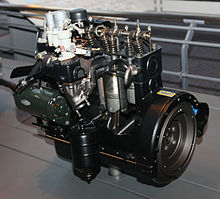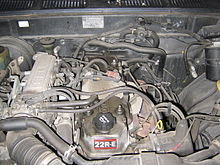Toyota R engine
Designed for longitudinal placement in such vehicles as the Celica and Hilux and in production from 1953 through 1997, usage faded out as many of Toyota's mainstream models moved to front-wheel drive.
[1] In common with new engines of the time, it was made from cast iron (both the block and the head), water cooled, used a three bearing crank, 12V electrics and a side-mounted gear-driven camshaft controlling overhead valves via pushrods in a non-cross flow head (exhaust and inlet manifolds being on the same side of the engine).
[1] Induction was by a twin throat down-draft carburettor, the compression ratio was 8.0:1 and the total weight was 155 kg (342 lb).
Road & Track was unimpressed with the engine on its introduction, noting that it idled quietly but was "not capable of very high revolutions per minute."
With a 2-valve SOHC head, it impressed contemporary reviewers – Road & Track praised its quietness and free-revving nature.
The 8R engine has a closed chamber head vs the open chamber of the 18R-C.[citation needed] The 8R-B has dual side draft SU-type Aisan carburettors with the float bowl under the body and vacuum activated power valves with strangle plates for chokes and liquid cooled intake with a balance tube.
From 1969 to Feb 1971 it was known as the 10R, but along with a removal of the tensioner gear in the interest of quieter operation, it was renamed the 8R-G to reflect the decision that twin-cam engines were henceforth to be identified by a "-G" suffix.
[7] 4,931 twin cam engines were built, all installed in the Toyota Corona Mark II (RT72) 1900 GSS.
The 10R/8R-G weighed in at 170 kg (370 lb) and as such was both lighter and more compact than its less powerful predecessor the 9R[8] Applications: The 1.6 L (1,587 cc) 9R was produced from 1967 through 1968.
Technical Specs (Finnish Owner's Manual from 1973 Corona Mark 1) – Four cylinder, 4-stroke, OHV – Bore × stroke: 80.5 mm × 78 mm (3.17 in × 3.07 in) – Compression ratio: 8.5:1 – Maximum power: 90 PS (66 kW; 89 hp) at 5400 rpm SAE The 12R-LPG, was produced from 1969 through 1983.
Technical Specs: 1975 59 kW (80 PS; 79 hp) redline 4,400 rpm Applications: The OHC 1.8 L (1,808 cc) 16R was produced from 1974 through 1980.
The 2-valve DOHC 18R-G and its variations were produced from 1973 to 1982, replacing the 8R-G and providing a performance engine which took advantage of the entire 2-litre limit of Japan's "small car" class.
[14] The Group 4 rally version of the 152E had two twin-choke carburettors, and developed 240 PS (177 kW; 237 hp) at 9000 rpm.
With a KKK turbocharger, the Group 5 Celica developed 560 PS (412 kW; 552 hp) but reliability was less than satisfactory.
Its dimensions are the same as of the 18R, but it featured TTC-V, Toyota's licensed version of Honda's CVCC stratified charge combustion system.
The 20R and subsequent models featured important design changes relative to the earlier SOHC R-series engines.
The head was changed from a reverse-flow to a cross-flow type with hemispherical combustion chambers and shorter valve rockers.
The lower block bearings were strengthened against wear, safeguarding oil pressure, and the stroke was lengthened.
Air injection and federally compliant emissions equipment for the 21R-C (1982–1985) dropped power down to 67 kW (91 PS; 90 hp) SAE net at 5,000 rpm.
If the engine continues to be operated without the guide restraint, the chain will vibrate excessively on the driver's side and stretch rapidly.
First, the loose chain will reduce ignition timing accuracy, which usually results in noticeably rough running.
Second, it may jump a tooth on the drive sprocket or break entirely, which almost always results in major damage to an interference engine.
Third, the stretched chain can slap against the side of the timing cover and wear through the metal into the coolant passage behind the water pump, resulting in major damage to both the oil and cooling systems (sometimes mis-diagnosed as a head gasket failure).
The damaged aluminum timing cover is difficult to repair effectively and is typically replaced after such an event.
These engines are extremely well known for their durability, decent fuel efficiency and good low to mid range torque.
The 22R has a large displacement and a strong block, but its comparatively long stroke and restrictive head limit its use in high revving applications.
The 20R head is a simple bolt-on modification for the pre-1985 block, but also requires the use of the 20R intake manifold, making it almost impossible (there's a lot of matching necessary) to use with the 22R-E EFI system.









